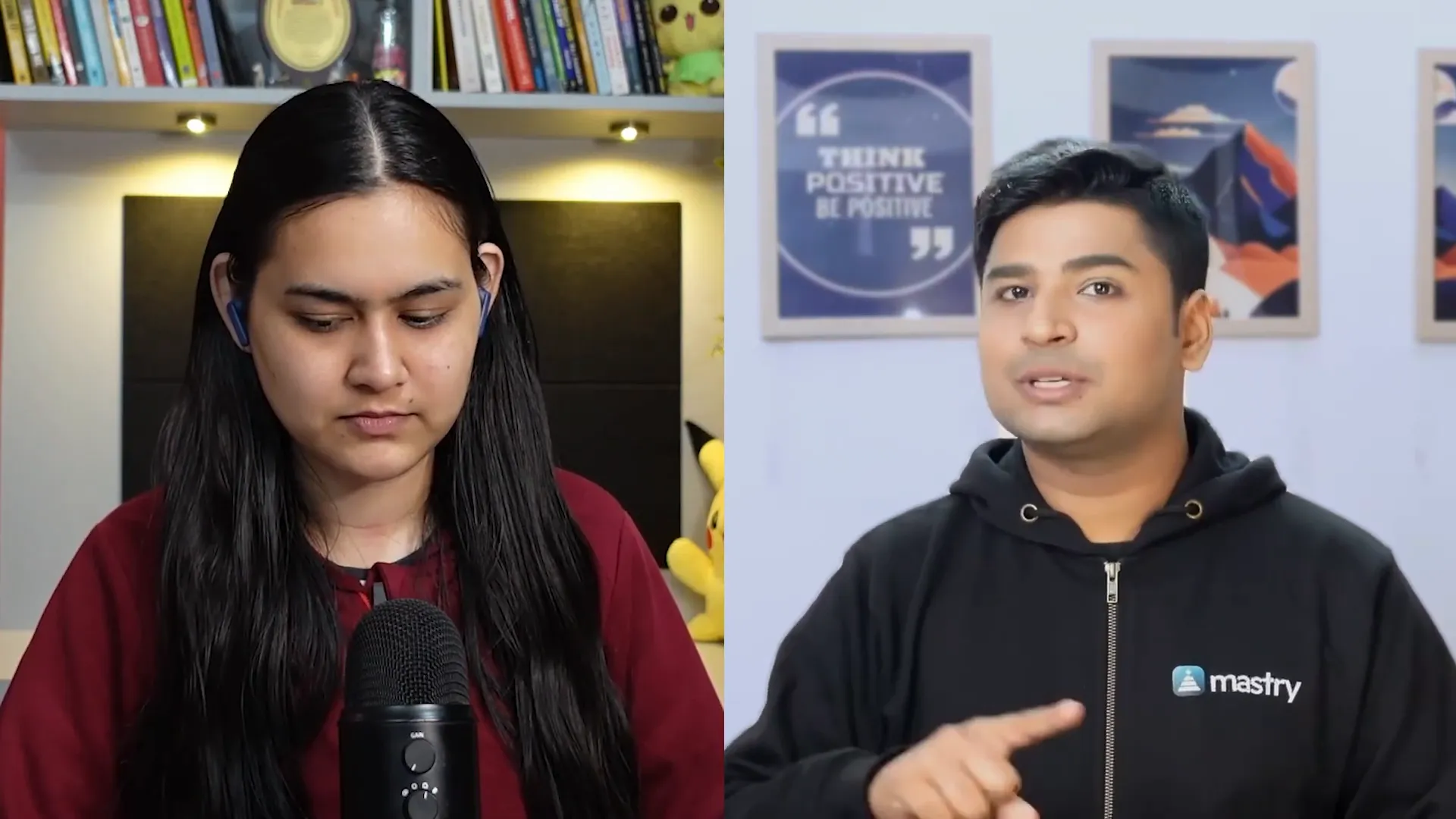My extensive list of skills
Interview with Rohan Mishra, Experienced UX/UI Designer, Teacher, and Entrepreneur: Complete Roadmap for a Successful UI/UX Design Career

In this comprehensive interview, we dive deep into the world of UI/UX design with Rohan Mishra, a seasoned UX designer with over eight years of industry experience. Rohan has worked with renowned startups like Zomato, Urban Company, and major companies in Dubai, Singapore, and Indonesia. Apart from being a practitioner, he is also a passionate teacher and entrepreneur who has mentored over twelve thousand students and hosted more than forty workshops.
This article is a must-read for anyone aspiring to build a career in UI/UX design. Rohan shares valuable insights on how to start your UI/UX design journey, the essential skills you need to acquire, how to build a portfolio, how to charge well, and much more. The conversation also touches on real-world challenges and offers practical advice not commonly found on the internet.
Whether you are a complete beginner or looking to switch careers, this interview will equip you with a clear roadmap and actionable tips to thrive in the UI/UX design field in 2025 and beyond.
Table of Contents
About Rohan Mishra
Anchal Tiwari: To start, can you please introduce yourself and tell our readers why they should pay attention to this podcast?
Rohan Mishra: Hi, my name is Rohan. I have been a UX designer for over eight years. I am also a teacher and an entrepreneur. My journey began in a tier-two engineering college where I had zero idea about what to do with my life. Initially, I realized that engineering might not be my future, so I started developing websites and later transitioned into graphic design and UI/UX design.
Over time, I noticed many of my classmates and juniors struggling to learn new skills and find opportunities. I started teaching them, which ignited my passion for teaching and entrepreneurship. Now, I run a business that provides some of the best UI/UX design courses and have mentored thousands of students who have successfully built careers in this field.
I have also worked with some of the biggest startups like Zomato and Urban Company and gained international experience working with companies in Dubai, Singapore, and Indonesia. In this podcast, I will share everything a new design aspirant or career switcher needs to know to build a successful UI/UX design career.

How did you discover UI/UX design, and what was your learning process like?
Rohan Mishra: When I started in 2015, I was initially doing web development. Some seniors in my college were working on government projects like result portals and websites for colleges, so I joined them as a web developer. But I quickly realized that the websites we were building were not user-friendly. They were cluttered, lacked proper navigation, and were hard to use.
This made me think about how to improve the user experience so that users could use these websites easily. At that time, UI/UX design was not a well-known term; most people only knew about graphic design. So I started learning graphic design, making posters in Photoshop, and gradually understood that what I really wanted to do was build websites and apps that offer a better user experience.
I reached out to many people on LinkedIn, asked questions, and learned that this field is called UI/UX design. UI/UX design focuses on improving how users interact with technology like websites and apps to make their experience seamless and enjoyable.

Did you start with graphic design before moving to UI/UX design? What would you recommend for beginners today?
Rohan Mishra: Yes, I started with graphic design because UI/UX design was not clearly distinguished back then. About ten years ago, many graphic designers were asked to do UI/UX tasks without proper knowledge of the field.
Today, if you're starting fresh, you can directly start with UI/UX design as long as you learn the fundamental principles of visual design, which are common to both graphic design and UI/UX. Learning graphic design first is not mandatory but can be helpful to understand visual hierarchy, color theory, typography, and layout.
So, beginners can pick UI/UX design straight away, but focus on visual design principles as a foundation.
For absolute beginners, what is the first step in learning UI/UX design? What tools and skills should they focus on?
Rohan Mishra: Great question. If you know nothing about UI/UX design, first understand what UI/UX design actually is. It is about designing the user experience for websites and apps. For example, think about apps like IRCTC, Zomato, Swiggy, or Uber. These apps offer services like booking train tickets, ordering food, or booking cabs. UI/UX design focuses on making these experiences easy and error-free for users.
To start learning UI/UX design, focus on three major parts:
- Learn tools and visual design principles: Tools like Figma are essential to create interfaces. You should learn how to use Figma to design screens and understand visual design concepts like hierarchy, contrast, alignment, and color theory.
- User research and problem-solving: Understand what problems users face and how to solve them. This requires product thinking skills where you evaluate how your design adds value to the business and retains users.
- Collaboration and communication: UI/UX design is not done in isolation. You work with product managers, developers, and other stakeholders. Being able to communicate your ideas clearly and collaborate effectively is crucial.
For example, in a payment app like Paytm, visual hierarchy ensures that the amount paid is most prominent on the screen, accompanied by smaller details like transaction time and recipient. Colors and animations convey success or failure of a transaction.
What resources do you recommend for beginners to learn tools like Figma and visual design principles?
Rohan Mishra: It is important to distinguish between tools and skills. Tools teach you how to create shapes, add text, and use colors in software like Figma. Skills teach you how to apply design principles like hierarchy, contrast, and color harmony to create effective designs.
Figma is currently the most popular tool, but before it, designers used Sketch, Adobe XD, Illustrator, and Photoshop. Tools evolve, but design principles remain constant.
For learning Figma, there are many YouTube tutorials and Figma's own library of fundamentals. For visual design, look for tutorials on graphic design and visual design principles. Study concepts like:
- Contrast
- Visual hierarchy
- Color theory and color harmony
- Typography
- Layout and alignment
A useful learning shortcut is the "copybook" method, where you replicate good designs you see (not for posting, but for practice). Try to analyze what makes a design appealing — colors, fonts, hierarchy, spacing — and apply those learnings to your own work. This practice sharpens your design eye and skills.
Once I learn some basics of Figma and visual design, what should I do next? Should I start building a portfolio or look for clients?
Rohan Mishra: Before building a portfolio, focus on understanding user problems and how to solve them. UI/UX design is about solving real user problems, not just creating pretty screens. No one pays for designs that don't add value or solve a problem.
So, the next step is user research and product thinking. Learn who your users are, what challenges they face, and what alternatives they currently use. For example, before Zomato, people used to order food by going to local restaurants or street vendors. Zomato simplified this by offering a convenient platform for food delivery.
By talking to people and asking questions about their experiences, you can identify pain points and design solutions. This process is fundamental before you start designing or building a portfolio.
As a beginner, how do I select which problems or segments to work on for my projects?
Rohan Mishra: This is a deep question. If you are working for a company like Uber or Zomato, your research questions will be related to their industry, like food delivery or cab booking.
If you are working on a concept case study without a client, start by introspection. Take pen and paper, and list things you spent money or time on in the last five days, or things that caused frustration. Identify which of these problems are common to others as well by talking to people.
For example, if you and several others face a problem with booking airport transportation, that could be a valid problem to solve. Then check if people are paying to solve this problem currently. If yes, that's a good indicator that your solution can add value.
Always focus on the core need rather than surface features. For example, Uber users' core need is "I want to get from point A to B at a specific time," rather than just "rate the driver."
How can freelancers conduct user research, especially if they are working from home and can't meet users in person?
Rohan Mishra: User research involves understanding users' goals, challenges, pain points, motivations, and capabilities. You can do this remotely through surveys and interviews.
Many companies conduct surveys to improve their services. You can create your own surveys targeting specific user groups. For example, if researching music streaming apps, ask users which platforms they use and why, rather than yes/no questions.
After collecting survey responses, conduct follow-up calls or interviews to dive deeper into users' reasons and experiences. This method is feasible for freelancers working remotely and provides valuable insights for design.
How long does it take to become proficient in UI/UX design by following this learning process?
Rohan Mishra: The time required varies, but adopting an MVP (Minimum Viable Product) approach helps. For example, learning the basics of Figma and creating simple designs can be done in 2-3 days. Mastering all features and making pixel-perfect prototypes may take 1-1.5 years.
Similarly, visual design has many elements to learn, but focusing on core principles like hierarchy and contrast can help you create good designs quickly.
User research has many methods, but you don't need to master all of them at once. Start by talking to users and asking open-ended questions. You will make mistakes initially, but practice will improve your skills over time.
Overall, within 2-3 months, a motivated learner can reach a good level to handle basic UI/UX projects and problem-solving.
Many designers charge vastly different rates for similar work, and some portfolios get rejected. Why does this happen?
Rohan Mishra: I like to explain this with an analogy of a water bottle. The same bottle of water sells for ₹10 in a local shop, ₹70 at an airport, and ₹150 on a flight. The product is the same, but the context and value perception differ.
Similarly, in design, you must first be really good at your craft. Then you need to understand who you are selling to and what problems you are solving for them. Smaller shops or local businesses may pay less because their problem is smaller or their budget is limited. Startups or bigger companies with higher stakes will pay more if you solve significant problems for them.
The key is to get good at design and pitch to clients for whom your work adds substantial value.
How can a designer identify target clients with good budgets and pitch to them effectively?
Rohan Mishra: After acquiring basic design skills, identify companies that make money through their websites or apps. A good indicator is companies that run ads to promote their digital presence, as they have budgets to spend.
One useful resource is Facebook Ads Library, where you can find companies actively advertising their products or services online.
The main problem these companies face is increasing conversion rates—turning more visitors into customers. Your job as a UI/UX designer is to help improve user experience to boost conversions.
For pitching, a common approach is to send cold emails introducing your services, highlighting relevant past clients, and offering to help improve their business. However, many people use this method, so you can differentiate by doing some preliminary work.
For example, analyze their website, identify 5-10 issues like lack of social proof or unclear product information, and suggest improvements. You can even make small sample changes and share these with the client to demonstrate your value. This proactive approach increases your chances of getting a response.
Additionally, if the brand is active on social media, you can share your observations and sample improvements there, increasing visibility and attracting more potential clients.
Won't doing preliminary work for clients consume a lot of time? How do you manage that?
Rohan Mishra: Don't do a full redesign or fix every issue. Focus on 5-10 key problems and spend 2-3 hours making meaningful improvements. This small investment of time will help you stand out and attract better clients.
Sending 100 generic applications won't be as effective as sending 10 personalized applications with value-added suggestions. This approach will also help you earn more money and onboard better clients.
If I start UI/UX design today and become good at it, how much can I expect to earn?
Rohan Mishra: As a UI/UX designer in India, the salary depends on your skill level, experience, city, and company. For beginners, the average salary in tier-one cities like Bangalore is around ₹7-8 lakhs per year. In tier-two cities, it may be around ₹4.5-5 lakhs per year.
With 10-12 years of experience, salaries can go up to ₹30-35 lakhs per year or more, especially if you work with big clients like Apple. Some top designers can even earn this amount per month.
Keep in mind that cost of living and company budgets influence salaries, but the key is to keep improving your skills and solving valuable problems.
What final tips would you give to new designers entering the UI/UX design industry?
Rohan Mishra: There are abundant opportunities in UI/UX design now and even more in the future. If you're entering this field, focus on creating value for businesses and users. Understand what is valuable to them—that is, what problems are scarce and need solving.
For example, if a brand has low user retention or customers are switching to competitors, solving these problems will make your work valuable and allow you to charge well.
Focus on solving meaningful problems with the skills you have, and your career will be fruitful.
Frequently Asked Questions (FAQ)
1. Can I start learning UI/UX design without prior graphic design experience?
Yes, you can start directly with UI/UX design today. However, learning visual design fundamentals such as hierarchy, contrast, and color theory is essential, which are traditionally part of graphic design.
2. How important is user research in UI/UX design?
User research is crucial as it helps you understand user problems and behaviors. Effective UI/UX design solves real user problems, so research guides your design decisions.
3. What tools should beginners learn for UI/UX design?
Figma is currently the most popular tool for UI/UX design. Beginners should focus on mastering Figma and the visual design principles alongside.
4. How can freelancers conduct user research remotely?
Freelancers can use surveys and remote interviews to gather user insights. Online survey tools and video calls make this process accessible from home.
5. How long does it take to become proficient in UI/UX design?
With focused learning and practice, beginners can reach a good level in 2-3 months to handle basic projects. Mastery takes longer and continuous learning.
6. Why do UI/UX designers charge different rates for similar work?
Rates vary based on skill level, client size, problem complexity, and value delivered. Experienced designers solving critical problems for big clients can charge more.
7. How do I find clients with good budgets?
Look for companies investing in digital ads or with active online presence. Facebook Ads Library is a useful resource to identify such businesses.
8. What is the best way to pitch clients?
Send personalized emails highlighting relevant experience and provide small value-added suggestions or sample improvements to stand out.
9. What is the earning potential in UI/UX design in India?
Entry-level salaries range from ₹4.5-8 lakhs per year depending on the city. Experienced designers can earn ₹30 lakhs or more annually.
10. What should new designers focus on to succeed?
Focus on solving meaningful problems for businesses and users, continuously improve your skills, and communicate your value effectively.
Thank you for reading this detailed interview with Rohan Mishra. For those serious about building a UI/UX design career, this roadmap and insights are invaluable. Remember, the key to success is combining good skills with a deep understanding of user problems and business value.

